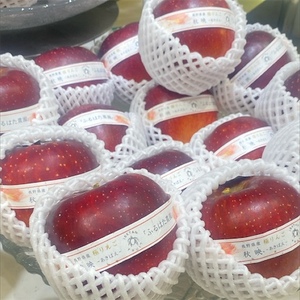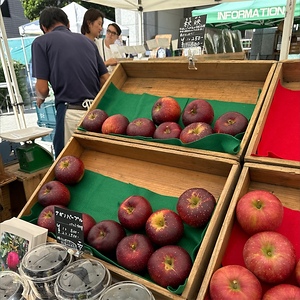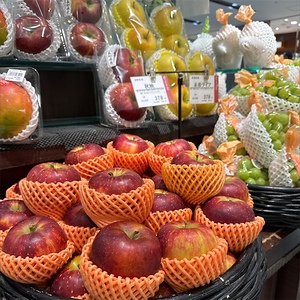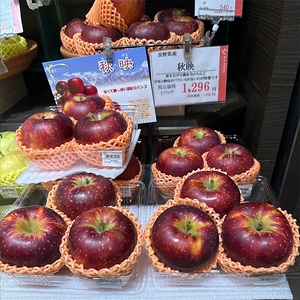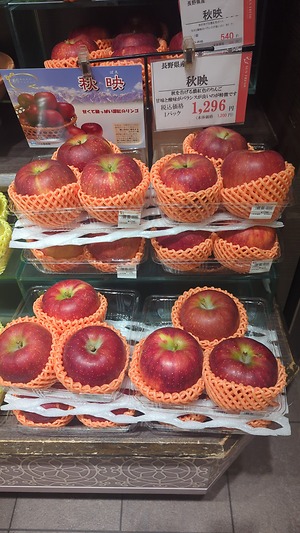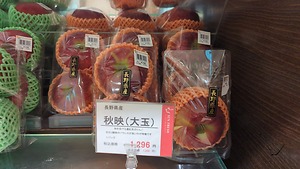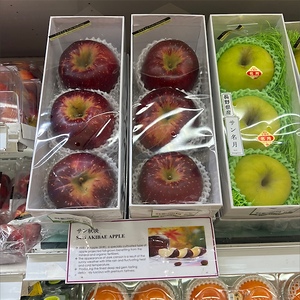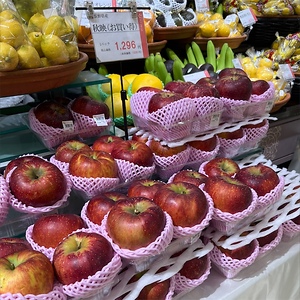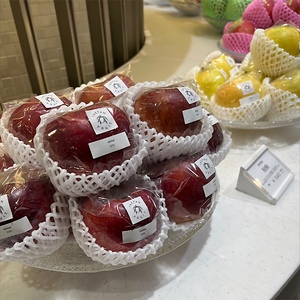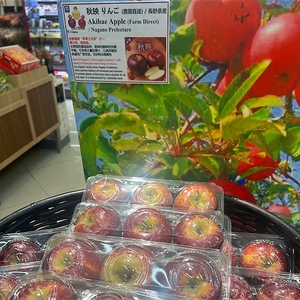


Akibae Apples
Estimated Inventory, lb : 0
Description/Taste
Akibae apples are moderately sized, round to conical fruits with broad shoulders and a narrow base. The skin is smooth, waxy, covered in prominent white lenticels, and has red skin that deepens in color when exposed to cold temperatures, sometimes appearing dark red, almost black. Underneath the surface, the flesh is pale yellow to ivory, crisp, firm, and aqueous, encasing a central core filled with small, black-brown seeds. Akibae apples are known for their crunchy consistency and have a balanced, sweet-tart flavor with moderate acidity. XXX
Seasons/Availability
Akibae apples are harvested in the fall and can be stored until the early spring in Japan.
Current Facts
Akibae apples, botanically classified as Malus domestica, are a mid-season variety that belongs to the Rosaceae family. The modern cultivar was naturally bred in the late 20th century in Japan and was selected for its unique red-black skin, balanced flavor, extended storage capabilities, and high yields. Akibae apples are primarily localized to Japan and are mostly unknown outside of the country, but the dark apples are considered a specialty cultivar that is sold at a premium price in local Japanese markets. The name Akibae roughly translates from the words “aki” and “bae” in Japanese to mean “beauty in fall,” and was derived from the fruit’s vibrant appearance. Akibae apples are highly favored for their dark red skin, and in cultivation, the colder the air, the darker the skin becomes.
Nutritional Value
Akibae apples are a good source of vitamin C, which is an antioxidant that offers anti-inflammatory properties and can boost the immune system. The fruits also contain fiber, calcium, phosphorus, vitamin A, iron, and potassium, which is an electrolyte that helps to regulate fluids levels within the body.
Applications
Akibae apples are best suited for both raw and cooked applications such as baking or stewing. The apples are most popularly consumed fresh, out-of-hand to showcase their crisp and juicy flesh and can be eaten with the skin on to retain its nutrients. The flesh can also be sliced and served on appetizer plates with cheeses, nuts, and dried fruits, chopped and tossed into green or fruit salads, pressed into juices and ciders, or blended into an apple sorbet. In addition to fresh applications, Akibae apples are sometimes utilized in cooked preparations such as apple curry, which is a stew-like dish prepared with apples, vegetables, and meat in a thick, brown gravy, or they can be cooked and served with roasted meats. The apples can also be baked into crumbles or pies and are a favored variety in Japan for invisible apple cakes, which are thinly sliced apples layered in a light batter. Akibae apples pair well with meats such as poultry, beef, pork, and fish, tofu, fruits such as pears, blackberries, and grapes, sweet potatoes, spinach, caramel, honey, maple syrup, and mascarpone. The fresh fruits will keep 1-3 months when stored whole and unwashed in the crisper drawer of the refrigerator.
Ethnic/Cultural Info
In Japan, Akibae apples are one of the most popular apple varieties featured at pick-your-own apple farms. Every fall during the harvest season, select farms in the region of Nagano allow visitors to tour the orchards, sample apple varieties, and learn about apple cultivation. Many of these farms offer both heritage and modern varieties, and some of the cultivars include fuji, shinano sweet, shinano gold, jonathan, and Akibae. Farms in Nagano also offer a unique opportunity for families to purchase a tree in the orchard. This recently created marketing campaign allows families to pick out a specific apple tree in the orchard, and when it is time for the fall harvest, the family can visit the farm, take pictures with the tree, and hand-harvest hundreds of fresh apples. The family also receives a sign in front of the tree, declaring that they have purchased the rights to the fruit. This campaign has become extremely successful for apple growers in Japan as it guarantees fruit sales, and for the urban consumer, it allows for a source of quality, fresh fruit.
Geography/History
Akibae apples were developed at an orchard in 1981 in the Nagano prefecture, which is one of the largest apple cultivation regions in Japan. The variety is a natural cross between tsugaru and senshu apples, and after its release, it became a registered commercial variety in 1993. Akibae apples also grow in the northernmost Aomori prefecture, which grows up to half of all of Japan’s apples. Today Akibae apples can be found at specialty markets, grocers, and farms across Japan.
Recipe Ideas
Recipes that include Akibae Apples. One
| Vanilla and Bean |
|
Beet and Apple Salad with Apple Cider Vinaigrette |
| Allergy Free Alaska |
|
Raw Beet, Carrot & Apple Salad With Ginger Lime Dressing |
| Daily Food Porn |
|
Generous Akibae Apple Brioche |



